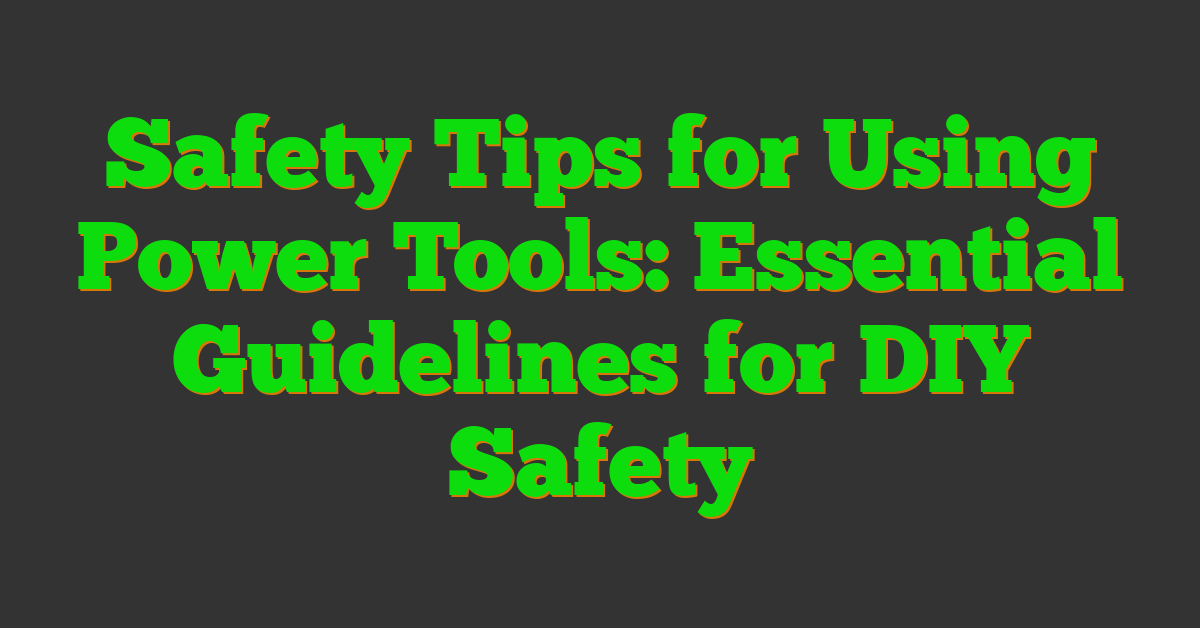Using power tools can transform your DIY projects from ordinary to extraordinary, but safety should always come first. I’ve learned that a few simple precautions can make all the difference in preventing accidents and ensuring smooth operations. Whether you’re a seasoned pro or just starting out, keeping safety in mind is essential every time you grab a tool.
Importance Of Safety When Using Power Tools
Using power tools enhances my DIY projects, but prioritizing safety ensures successful outcomes. Accidents can happen quickly, making safety measures essential. I always follow manufacturer guidelines to understand each tool’s proper use and potential hazards.
Wearing appropriate personal protective equipment (PPE) minimizes risks. Safety goggles protect my eyes from debris, while gloves prevent hand injuries. Hearing protection safeguards against noise-induced hearing loss during prolonged use. Additionally, wearing sturdy footwear reduces the chance of slips and falls.
Maintaining a clean workspace contributes to safety. I keep my area free of clutter to prevent tripping hazards and ensure easy access to tools. Proper storage of power tools when not in use also reduces the risk of accidents and extends the tools’ lifespan.
Regular maintenance of power tools is crucial. I inspect tools for damage before each use, checking for frayed cords or worn parts. Keeping tools sharp and well-lubricated ensures they operate smoothly, reducing the likelihood of malfunctions.
Understanding the correct operation of each power tool is vital. I take the time to read instruction manuals and, if necessary, watch tutorial videos to familiarize myself with the tool’s functions. Proper training prevents misuse and enhances efficiency.
By emphasizing safety, I create a secure environment for my projects. These practices not only protect me but also allow me to focus on achieving high-quality results with my power tools.
Essential Personal Protective Equipment
Using the right personal protective equipment keeps me safe while operating power tools. Here’s what I always make sure to wear.
Eye Protection
I always wear safety goggles or a face shield to protect my eyes from debris and sparks. Safety goggles offer a snug fit, blocking out small particles, while face shields provide full-face coverage for intense tasks. When sanding or cutting, goggles with side shields are essential to prevent particles from entering from the sides. Anti-fog lenses keep my vision clear, especially in humid conditions.
Hearing Protection
Power tools can generate harmful noise levels, so I use earplugs or earmuffs to safeguard my hearing. Earplugs are lightweight and fit inside the ear, offering discreet protection for prolonged use. Earmuffs cover the entire ear, providing superior noise reduction for louder tools like saws and drills. Consistently wearing hearing protection prevents long-term hearing damage and ensures a more comfortable working environment.
Proper Tool Maintenance
Maintaining your power tools ensures their longevity and safe operation. I follow these key practices to keep my tools in top condition.
Regular Inspections
I perform regular inspections to identify any issues early. This includes:
- Blade and Bit Checks: Ensure blades and bits are sharp and free from damage.
- Cord Inspection: Look for frays or cuts in power cords to prevent electrical hazards.
- Safety Features: Verify that guards and switches function correctly.
- Fasteners: Tighten any loose screws or bolts to maintain tool stability.
Cleaning And Storage
- Wipe Down Tools: Remove dust, debris, and residue after each use with a clean cloth.
- Lubricate Moving Parts: Apply appropriate lubricants to reduce wear and ensure smooth operation.
- Dry Completely: Ensure tools are dry before storage to prevent rust and corrosion.
- Organized Storage: Store tools in a dry, designated area, using racks or boxes to keep them organized and easily accessible.
Correct Handling And Operation Techniques
Operating Procedures
I always start by reading the tool’s manual to understand its functions and safety features. Before turning on any power tool, I ensure it’s unplugged or the battery is removed. I check for any visible damage, such as frayed cords or loose parts. When operating, I maintain a stable stance and keep both hands on the tool to control it effectively. I adjust settings like speed and depth according to the task, ensuring precision and safety. After use, I turn off the tool and disconnect it from the power source.
Avoiding Common Hazards
I prioritize keeping my workspace clean to minimize tripping and accidental tool contact. I use guards and safety features provided with each tool to prevent injuries from moving parts. I always wear appropriate PPE, including gloves and safety goggles, to protect against debris and sparks. I avoid distractions and stay focused on the task to reduce the risk of mistakes. Additionally, I never force a tool beyond its capacity, which helps prevent overheating and equipment failure.
Safe Workspace Setup
Creating a safe workspace is essential for minimizing risks when using power tools. I ensure that my workspace is well-organized and equipped with necessary safety features.
Adequate Lighting
Proper lighting enhances visibility and reduces the chance of accidents. I use bright, overhead LED lights to illuminate the entire workspace. Task lighting, such as adjustable workbenches lamps, helps me see detailed work clearly. Natural light is also beneficial, so I position my workspace near windows when possible.
Ventilation And Dust Control
Effective ventilation maintains air quality and prevents respiratory issues. I install exhaust fans to remove dust and fumes generated during tool use. Additionally, I use dust collection systems connected to my power tools to capture debris at the source. Wearing a respirator complements these measures, ensuring a safe breathing environment.
Tips For Specific Power Tools
Using power tools safely requires understanding the unique risks each tool presents. Here are tailored safety tips for common power tools.
Circular Saws
- Wear Protective Gear: Always use safety goggles and hearing protection to shield against debris and loud noise.
- Check the Blade: Inspect the blade for damage or dullness before each use, ensuring it’s suitable for the material you’re cutting.
- Secure the Material: Clamp the workpiece firmly to prevent movement during cutting, reducing the risk of kickback.
- Maintain a Stable Stance: Position yourself with a balanced footing and keep both hands on the saw to maintain control.
- Avoid Freehand Cuts: Use a guide or saw table to ensure straight, accurate cuts and minimize accidental slips.
- Disconnect When Adjusting: Unplug the saw or remove the battery before changing blades or making adjustments to prevent accidental starts.
Drills
- Use the Right Bit: Select a drill bit appropriate for the material and task to enhance efficiency and reduce tool strain.
- Secure the Workpiece: Clamp the material securely to prevent slipping and ensure precise drilling.
- Maintain a Firm Grip: Hold the drill with both hands to control speed and torque, minimizing the risk of injury.
- Check for Obstructions: Inspect the drilling area for hidden wires or pipes to avoid accidental damage or electric shocks.
- Control Speed: Adjust the drill’s speed setting based on the material to prevent overheating and ensure clean holes.
- Inspect the Drill: Regularly examine the drill for wear or damage, replacing worn parts to maintain safe operation.
Conclusion
Working with power tools can be incredibly rewarding when done safely. I always feel more confident knowing I’ve taken the right precautions. By staying mindful and prepared you ensure each project is not only successful but also safe. Happy building and stay safe out there!
« How to Prevent Plant Diseases: Essential Tips for a Thriving Garden Winter Maintenance Tasks for Outdoor Spaces: Essential Tips to Protect Your Yard »

















